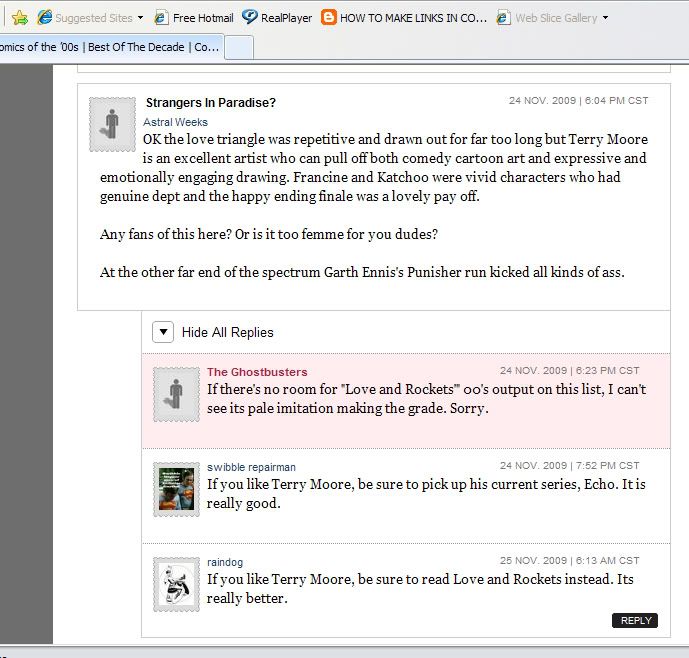Monday, December 28, 2009
What Would Happen If a Massive Earthquake Struck Tokyo: Tokyo Magnitude 8.0
The image of the famous Shibuya scramble, its giant Starbucks and iconic, cylindrical Ichi-Maru-Kyu building with everything wrecked and ruined is startling and effective. In that it startled me to see a place I often visit completely devastated and abandoned and it effectively made me want to see the anime and buy the comic.
Tokyo Comic Book Report: December 2009
Hitting up Blister in Harajuku for the latest American monthly comic book magazines. Unfortunately, this time around the pickings were pretty slim. I must have hit Blister at an off time. The most recent offerings from DC and Marvel were available, but not stocked very deeply. There were absolutely no issues of Batgirl to be had either on the main shelf or in the back-issue bins, no new Astonishing X-Men, very little Dark Horse other than Buffy the Vampire Slayer, Conan the Cimmerian and one BPRD title. However, if you want a nearly-complete run of Wildstorm's Gen13 series, you're in luck; they have practically every issue, plus some from the earlier volumes. I didn't buy any of them. The ready availability of Gen13 is probably not a good sign for that title (I can't believe it's still being published), but I imagine the scarcity of everything else points to robust sales here in Japan for those titles.
I bought the fifth and final issue of the Batman: Unseen miniseries with a Doug Moench script and Kelley Jones art. While I'm not a big Kelley Jones fan, the comic looked oddball enough to attract me, and I had yen to burn. Actually, I gave it a try because I was desperate.
In this story, Batman takes an invisibility formula and turns into slightly more of an asshole than usual (I don't understand the big deal about Batman taking super-steroids and getting 'roid rage or going insane with power under the influence of some H.G. Wells invisibility formula when for the past few years he's been written as a borderline psychotic anyway). And Jones makes Batman's silly bat-ears look as though they're three feet long. And gives the Caped Crusader a pinhead on top of a grotesquely bulbous body.
I noticed from Dark Horse's house ads (and even in the Conan letter page) they're positioning themselves as even more of an alternative to DC and Marvel as they trumpet their standalone titles. Counterprogramming for those of us burned out on massive crossover storylines and the expectation from the Big Two that we're just dying to buy 20 comics a month to get a complete plot... which they'll just un-do and render superfluous as soon as it becomes inconvenient or problematic for the next giant crisis. Well, maybe most superhero comic fans do like those kinds of things because they seem to top the sales charts.
But for me, these enforced participation in crossovers interrupts the narrative flow of whatever monthly I'm reading. Case in point-- just when I was starting to enjoy New Mutants, all developing story threads get temporarily tossed as the team crashes headlong into an boneheaded issue where they fight zombie versions of their old enemies because of "Necrosha X," some overarching X-title event that just seems the tiredest, least essential crossover so far. I couldn't even enjoy the return of a couple of familiar characters from the first New Mutants series.
I bought this issue because I'm following this one title; it was nothing but yawn-inducing superheroic fisticuffs (nice Adam Kubert cover, though), so not only has Marvel failed to interest me in buying other books to follow this inane storyline, they've killed a lot of my interest in New Mutants as well.
This just makes me like Dark Horse even more. It's simple-- they publish more of the titles I enjoy than any other company and I rarely feel ripped off or insulted after reading them. Their books give you a genuinely pleasurable reading experience that doesn't feel like a hollow marketing stunt masquerading as a story. I even bought odd-sized Empowered special, "The Wench with a Million Sighs." My final purchase consisted of 5 Dark Horse books, two issues of Marvel's New Mutants (one of which turned me off) and a single DC offering.
But since Blister's shelves seemed as bare and uninviting as the Cratchits' pantry in A Christmas Carol, I didn't spend too much time there. Also because there was just too much to see in and around Harajuku. Lights, Christmas trees, beautiful young people walking together in pairs. A river of red brake lights on Omotesando-dori competing with the glittering decorations in the trees lining the street.
Kinokuniya behind Takashimaya in Shinjuku still has a decent selection of graphic novels, heavy on the mainstream stuff, although Alan Moore's works are heavily represented. This is your most reliable source for newer English-translation manga volumes; they have a relatively huge selection that compares favorably with American chain bookstores. I picked up Nana 18 and 19 there. At Tower Records in Shibuya I bought the last battered copy available in Japan of Jaime Hernandez's Love and Rockets Library (Part 1): Maggie the Mechanic. Tower carries a lot of Fantagraphics' books, but they don't seem to be stocking Love and Rockets New Stories; I buy those from Amazon.co.jp.
Tower Records has also expanded their English-translated manga section onto a second shelf. Not as extensive as the stock at Kinokuniya, but still worth a look.
And that's what a comic book Christmas in Tokyo was like in 2009.
Happy Birthday Stan Lee!
He really shouldn't have been there. In March of that year, President Jimmy Carter declared a boycott of the Summer Games to protest the Soviet Union's invasion of Afghanistan. Undaunted, Stan "The Man" Lee had himself smuggled into Moscow Olympic stadium and, despite being 57 years old, set several world records during the decathlon event.
In the aftermath of Lee's stunning victory, the Games descended into chaos. General Secretary Leonid Brezhnev demanded the International Olympic Committee invalidate Lee's results and several nations filed official protests. An embarrassed President Carter was forced to issue a proclamation naming Lee an American hero and patriot despite his having ignored the presidential order. And when asked by reporters about his heretofore unknown athletic prowess, Lee simply smiled and replied "Excelsior!" He then soared majestically into the clouds.
Nine years later, the Soviet Union was no more but Stan Lee was still hard at work creating new heroic worlds to the delight of children everywhere, and he continues doing so to this day. He even occasionally writes about some of these in comic book form.
Excelsior, indeed, Stan Lee! Many happy returns of the day!
Thursday, December 24, 2009
A Very Macabre Christmas To You All!
 And one to me as well. This year I received my traditional Jack Kirby gift, volume three of DC's wonderful Jack Kirby's Fourth World Omnibus series, completing the set. I also got Drawing Words & Writing Pictures by Jessica Abel and Matt Madden; it's "a definitive course from concept to comic in 15 lessons." I hope to put that one to use.
And one to me as well. This year I received my traditional Jack Kirby gift, volume three of DC's wonderful Jack Kirby's Fourth World Omnibus series, completing the set. I also got Drawing Words & Writing Pictures by Jessica Abel and Matt Madden; it's "a definitive course from concept to comic in 15 lessons." I hope to put that one to use.One Piece Is Setting Records!
Still, the number boggles the mind. How many prose novels have print runs as large? Murakami Haruki's latest novel 1Q84 had its print run increased by 100,000 to 480,000 copies when it proved to be an enormous hit, but I'm not sure of the total. The current prose record-holder is Dan Brown for his book The Lost Symbol with 6.5 million. For a comic book to be even in that general vicinity, that a national newspaper would run a story on it and that it has 176 million copies in circulation in a nation of roughly 127 million people is quite an achievement and a testament to One Piece's pop cultural impact since its 1997 debut.
For more perspective, the 300 ranked monthly magazines in the U.S. sold 6.24 million combined copies in October of this year. The single best-selling comic that month was DC's Blackest Night #4, which moved 137,086 units. While it's not really fair to compare directly a single volume of a manga series-- especially one printed in graphic novel form-- to books that come out as monthly magazines, you can still draw some inferences about comic book readership in Japan versus that in America. To wit, many more people are reading comics in Japan than in the United States.
And most of those people probably don't give a shit about Blackest Night.
Oh, and the previous sales leader in Japan was a comic book about basketball. Are there any comics about sports in the U.S.?
Tuesday, December 22, 2009
Do You Like Classics Turned Into Comics?
Well, maybe not all that fresh. I bought grimy copies of Classics Illustrated comics or something similar from a flea market just outside the city limits back in the early 1980s. The original line of Classics Illustrated goes back to 1941. Their adaptations were highly condensed and, in some cases, somewhat sanitized. But they were limited by page counts and the mores of the time; literary classics might contain scenes to make young readers uneasy or question authority or do something un-American or-- God forbid-- pro-Red!
Today companies seem to be taking advantage of what I hope is a more sophisticated readership and the increasing willingness of bookstores and libraries to stock comic books. You know, graphic novels. This means they can include episodes from their adaptations of things like H.G. Wells' War of the Worlds that past audiences might have found distasteful or challenging. Even much maligned Marvel has a line of these hoity-toity books and they seem to be doing it full tilt boogie, or at least making the attempt. From the article:
Ralph Macchio, editor of Marvel Illustrated, a line of comics adaptations, says the company wanted to “take some classics and give them the full treatment; we didn't want to skimp or compress, [but] to do justice to the full flavor of the novel.”
Well, I'm as guilty as any comic fan when it comes to bitching and moaning about what the American companies are doing wrong. This is a case where I think they're doing right. Rather than a severely expurgated version of these stories, which really just serves as a quaint but pale substitute for the original prose-- and perhaps even a sub-literate one at that-- it seems like today's publishers are trying to make these legitimate adaptations in their own right.
And it's not just Marvel. Papercutz has the original Classics Illustrated label, but Penguin is doing Puffin Graphics (oh baby, I've got to get their version of Stephen Crane's The Red Badge of Courage, by the way). You can read about the others in the PW article. Some of these companies are taking a novel, inspired approach and putting out Shakespearian adaptations with manga-style art. Okay, so sticking Macbeth and Lady Macbeth on a ringworld in distant solar system may not be the way to go, but otherwise why not try to tap into that demographic? As long as the words are Shakespeare's, the art can look any old way you think might get some 14-year-old excited about reading stuff originally written 400 years ago. Other authors could benefit from this approach, too.
After all, doesn't your mind's eye view of Huckleberry Finn resemble Monkey D. Luffy? A little? Oh come on, he's wearing a straw hat, for the love of corn!
While these new books seem to be relying heavily on the familiar-- lots of Mark Twain, Jane Austen, Charles Dickens and James Fenimore Cooper-- there's a reason these books have become classics. And that's their enduring richness. These books are rarely the same twice and often reward re-reading with new insights and new excitements. So why not adapt them again and again, taking different approaches each time?
Whether or not these books sell... that's a different story. I hope they do. And I hope they fulfill Classic Illustrated's original mission-- get people interested in reading for fun those books whose cultural reputations teachers have ruined for generations by forcing them to read.
Monday, December 21, 2009
Iron Man 2 Trailer...
Oh wow, it's been a while, huh? I hope you enjoyed three-quarters of the trailer for Iron Man 2. I really need to fix this template if I'm going to do things like this, huh?
The first movie had a brief run here in Japan last year and I finally caught it on Star Channel Sunday night. Now I like Jon Favreau and Robert Downey, Jr. a lot but I had zero expectations going into this movie. Sure, the first image I saw a couple of years ago featured a fairly faithful version of Iron Man's earliest armor, which garnered a certain amount of good will from yours truly.
But I'm just not that big an Iron Man fan, even less so now that he has crazy cyber-nano virus whatever garbage as part of his powers. I mildly liked him when he was just a rich alcoholic war profiteer with a suit. The movie's Tony Stark?
Played to the hilt by Downey, Jr., he makes being an irresponsible cad with unlimited resources, fame and power look every bit as fun as I imagine it would be. Favreau's direction is surprisingly crisp and assured in the action sequences. After all, I knew he'd have no trouble eliciting good performances from the cast-- Gwyneth Paltrow is quite charming, Terence Howard provides conscience and kudos for Favreau for getting some evil-eyed intensity from Jeff Bridges. I still picture Bridges as the Dude and it's hard to get past that; now I'm looking forward to his turn as Rooster Cogburn in the Coen Brothers' adaptation of Charles Portis's novel True Grit.
But this is really Robert Downey, Jr.'s movie and he-- more than anyone-- really makes it hum.
Where do I place Iron Man on my list of Best Comic Book Adaptations? It's not quite as powerful as The Dark Knight, my reigning champ. But it's roughly as enjoyable as Spider-Man 2, my strong #2. By the way, #3 is Superman: The Movie. And to be totally honest here-- I usually hate comic book adaptations. Well, the mainstream superhero ones anyway. I enjoyed Ghost World and A History of Violence and both of those seemed well divorced from their source material. Although in Ghost World's case, it would've been better had they been a bit more true to the original story's melancholic, alienated tone rather than turn it into a joke-fest where a lot of the lines seemed forced. It takes a lot to impress me with a comic book movie and, as a film, it has to stand up against non-genre films. Few do.
Which is why I believe both Fantastic Four movies to be rotten lumps of celluloid shit, for example. So if I tell you I enjoyed Iron Man, that's saying quite a lot.
Thursday, December 10, 2009
And My Final Word on the Earth One Concept...
Sure, Grant Morrison did a lot of nostalgia referencing in All-Star Superman, but note the verb tense. Did. It's been done and done well. Ditto for numerous retellings of Superman and Batman's beginnings. All-Star Superman took elements necessary to the stories but freed the Superman concept from the creativity-crushing effects of having to shoehorn monthly plots into this overarcing universe narrative. Instead, we readers got a basic, cleaned-up Superman who seemed fresh yet comfortably familiar.
I know there are more fans who feel if the story's not part of the ongoing DC narrative-- if it's not "canon"-- then it somehow doesn't count than fans like me who simply want a good story taking the best elements of the characters. To canon fans, quality is sometimes secondary. They want to feel as if the story they're reading is part of the character's official biography. Otherwise they feel cheated.
Actually, the characters don't need to be "rebooted" or "revamped." They're fine as they are. They just need all the years of crap surgically removed and allowed to stand on their own again. And hopefully these Earth One books will do that for Superman and Batman and let us see exactly what it is we so enjoy about the two of them in the first place.
But I honestly don't want to read one hundred pages of something that seems like a half-assed Smallville adaptation or a paler version of Batman Begins.
Wednesday, December 9, 2009
More on DC's Earth One Experiment...
I foresee an immediate appeal to myself if the stories and art are up to snuff, but I wonder if they're ultimately doing these for an audience of one.
And I'm far from the typical "modern comic reader."
After all, I once called for the complete abandonment of the monthly magazine, an idea that gives ordinary comic shop patrons nightmares. While I prefer the novel format, I worry these new books might end up being mere curiosities, making a big splash due to their newness but in the end, not self-sustaining.
So it's a risk, and a calculated one. If it doesn't work, at least we'll have a few interesting books to read and a marketing concept to dissect. And I've long championed new formats for sequential storytelling. I'd love for this to work, moreso if the books themselves have any kind of quality. In fact, I'd love for them to push the concept even further.
DC's Earth One Graphic Novels: Haven't I Been Asking For This All Along?
Anyway, I never thought I'd type this sentence but: Way to go, DC! Finally, bookstore-type books without the accumulated baggage of seventy-plus years of continuity. There's Superman: Earth One with J. Michael Straczynski writing and Shane Davis drawing. I haven't read any of Straczynski's comic book work but I occasionally enjoyed Babylon 5 while eating frozen pizza, which gives you a horrifying glimpse into the sparse nightmare that was my life in the mid-1990s. Shane Davis? Never heard of him at all. And then there's Batman: Earth One with Geoff Johns scripting and Gary Frank doodling away. I'm fairly familiar with Johns and I'm quite the fan of Frank.
Not that I'm taking credit for this idea in any way, but I believe I frequently begged, cajoled and threatened suicide over just such a project. In fact, when I asked for something similar on my old blog two or three years ago, someone on Live Journal called me an idiot. Or a moron. I can't remember which. And now it seems DC is fulfilling my wish and I couldn't be happier.
Depending on how the creative teams execute this concept. As Noel Murray of the Onion A/V Club writes:
The last thing the genre needs are more drawn-out revisitations of old mythology. ("Oh look, Krypto's back. Again. And here's how Clark Kent met Lex Luthor. Again.") Enough with the nods and winks to the fans. Here's hoping that if this series is really aimed at new readers, it'll actually be new.
Yeah, no cutesy, nostalgic stuff. Just get on with telling rock-solid stories with these characters. No cross-overs, no comic booky nonsense. While I want them to avoid nostalgia, I hope they do clean, iconic versions of Superman and Batman without pandering to the kind of nihilistic "the world is a nasty, horrible place so we want nasty, horrible anti-heroes" of the kind we've been getting via All-Star Batman and Robin and even a lot of the regular monthly books. Don't try to compete with Watchmen and don't try to rewrite The Dark Knight Returns or Batman: Year One.
Don't pre-suppose our interest in Supes or Bats or their supporting casts and use that as an excuse to shorthand the character development or get lazy with the writing. Just treat these books exactly like you would if you were writing prose novels.
The only thing I'm not thrilled about is that these are series rather than stand-alone graphic novels. I'd prefer they allow creative teams to do one-offs free of all constraints save those imposed by real literary stylings. Especially free of the need to create a "tentpole" property and then fall into the same traps as the magazines have-- no real development of the protagonists, stories that never end and an ever more burdensome need to maintain universe-wide continuity as opposed to just story continuity.
Single books would be really revolutionary. Imagine how suspenseful a Batman story would be if you felt the Caped Crusader were actually in some kind of jeopardy because you had no idea if he would survive in the end.
Of course, no Frank Miller participation is immediately a good sign.
Sunday, December 6, 2009
Dark Horse Comics, Why Must You Make Me Love You So?
I sure do. I put them at roughly the same level as the pre-Ultraverse Malibu Comics-- black and white comics featuring properties that held absolutely no interest for me. Then came the early 90's color boom and Dark Horse started publishing Mike Baron and Steve Rude's Nexus, John Byrne's John Byrne's Next Men and Mike Mignola's Hellboy. Of course Nexus and Next Men went on to become mega-blockbuster Hollywood hit movies with multiple Academy Award nominations and wins, and spawned entire cottage industries of Horatio Hellpop and Sundra clothes lines, a long-running TV series (Jasmine Loves Jack) and theme parks around the world. Just last week I visited Tokyo Ylum and bopped to the music of Mezz, a minor character especially beloved here in Japan.
Poor Hellboy just seemed to vanish without a trace. Whatever happened to Mike Mignola anyway? Is he still drawing?
Publisher loyalty is a concept that's foreign to me. I tend to buy books based on whether or not I like the creators involved or the characters rather than what logo is in the upper left corner. But increasingly I find myself enjoying Dark Horse's product. Their various Conan series, Hellboy and BPRD, their Nexus Archives and the Creepy/Eerie books as well. It hasn't escaped my attention they publish thousands of Star Wars-related books a month, either. They dared issue Ito Junji's sickening horror comics. For that alone they deserve praise. But they also reprinted Marvel's old Conan the Barbarian comic in full color, plus Savage Sword of Conan in an affordable "phone book" volume.
A few months ago, one of my students saw me reading an American comic and wanted to borrow some to practice her English. I chose a selection I thought might interest her and also give her an idea of the various genres and companies we have in the States. Batgirl, Astro City and Hellboy and BPRD. I really thought she'd dig Astro City, but it made almost no impact on her. Instead, she went gaga for BPRD. She loves Guy Davis' art and simply cannot get enough of Abe Sapien and Panya. As a matter of fact, Panya is her favorite comic book character now!
But it gets even better for the Horse and its readers. Just recently, the Onion A/V Club listed their "Best Comics of the 00's" and I ripped into them for not including Japanese comics. But it's interesting Dark Horse Comics managed to place three titles on that list: Achewood, The Goon and Usagi Yojimbo. Amazingly, I haven't read any of them. The Goon and Usagi Yojimbo have been on my "as soon as I get around to them" list for years now. Perhaps now is the time. Dark Horse has also won the most Eisners of any publisher two years in a row now. Hellboy: The Crooked Man certainly deserved its award; that mini just oozed quality, from Mignola's spare, moody script to Richard Corben's lush, disturbing artwork.
And get this-- Dark Horse has also re-vamped Creepy as a comic book-sized quarterly. From the pics I've seen online, this book looks gorgeous. The new Creepy is something (if I could actually buy it here in Japan) I'd be looking forward to with sweaty palms and heart palpitations for the full three months between issues. I checked out the online previews and it's everything I'd hoped when I learned they were doing this. Eric Powell's covers are appropriately Frazetta-esque, perfectly lurid and grotesque; The background colors-- especially the vivid red on the first issue-- are very reminiscent of the original magazine and even the cover copy has the correct typeface. They bring back that weird feeling from the days when both Creepy and Eerie lurked there on the bottom of the magazine shelf near the comic book spinner at the Kwickee store. Just a fleeting glimpse was often enough to send a chill down my spine or inspire nightmares. Forty-eight pages of black and white horror in the Warren Publications tradition-- they've even got Angelo Torres and Russ Heath!
That's what inspired this Dark Horse celebration. A little epiphany inspired by the existence of the new Creepy. I suddenly realized it was impossible for me to dislike a company that puts out Creepy? And the more I thought about it, the more I realized my apartment here is overflowing with comics, the bulk of which happen to have the Dark Horse logo. I'd honestly never really considered that before. Apparently, I like Dark Horse Comics.
A lot.
Thursday, November 26, 2009
Wednesday, November 25, 2009
More on The Onion A/V Club's "Best Comics of the 00's" list...
The comments make for some great reading, as well. Specifically because Noel Murray of the A/V Club makes an appearance to discuss all the furor the list has generated. Murray's one of my favorite A/V Club staffers and I always enjoy his reviews. Let's look at what he's saying:
"Well, if someone made a "Best Music of the '00s, Except Hip Hop, Because Not Everyone Listens to Hip Hop, And That's Totally Fine" list, I think people would be calling bullroar on that too."
What if you released a list of Best Music Of The '00s and included no classical? Because that's actually fairly common.
If Rolling Stone or Spin releases a "best music" list with no classical or jazz, it wouldn't be nearly so surprising as it would be if they left off hip hop-- although they may stick some select classical titles on there just to cover their asses. If The Source releases a list that's totally hip hop, or Vibe releases a similar list that was entirely hip hop or R&B with no college radio rock or country music, who could argue with their logic?
But if Time magazine or Entertainment Weekly releases a "best of music" list without including classical, jazz or hip hop... something would be pretty stinky. And people would quite rightly don gas masks or at least clothes pins (do those even help, outside of cartoons?) when approaching the list. The Onion A/V Club is a more general pop culture media outlet, so the manga exclusion is pretty obvious.
Our comics coverage has always been manga-lite, but I'm not sure "don't care" is the right word. We dabble; we just don't delve. But again, your criticism is fair, and perhaps we should look into finding someone more manga-literate to supplement our future coverage.
Not necessary, actually. "Manga-literacy" is a redundancy. Literacy will suffice, and the A/V Club obviously has tons of that. Just read some Japanese comics with the same critical eye you read Western works. You don't have to approach manga as if it's an alien species. I don't read a manga and judge it based on manga tropes or even a vast understanding of Japanese culture; I read it and judge it based on my experience reading literature of all kinds, prose included. In fact, that's the standard by which I judge any comic I read.
I do take issue with the idea that lists like this don't "help anybody" though. I go back to my earlier comment: It depends on who you think lists like this are designed for. If you're deeply into comics, you're right, our list probably just confirms what you already know. If you read comics casually, you're likely to find some new things to check out. And if you're a complete novice... well, I offer a variation on what I asked Sean earlier: Do you not feel that the books on this list are, generally speaking, well-worth a reader's time?
I'm agree with Noel on some of these points. These lists are not only helpful-- perhaps even more so when fatally flawed like this one-- but almost always entertaining. Except... by leaving out manga from the list, you've accidentally cut this hypothetical "casual reader" off from most of comics culture. And some of the absolute best comics creators and their work. Takahashi Rumiko, Yazawa Ai, Ito Junji, Tezuka Osamu, Koike Kazuo and so many more; we're not talking about the merely good-- these are world class creators who have impacted the overal medium to a level that would probably shock the Ameri-centric comic book reader.
Like me. When I discovered this, I realized I'd been living in a comic book cell, like a cloistered monk who eventually forgets there's a sun causing that shaft of light that travels up the wall every day.
It's exactly like making a best of list and neglecting Alan Moore, Jack Kirby, Stan Lee, Warren Ellis, Los Bros Hernandez, Robert Crumb, Moebius and so forth. Oops!
And I definitely think the list's selections are worthy. The many I've read really did rock my socks. Again, it's not what's on there that's the problem. It's the absence of a huge chunk of comics that should be on there-- and not the individual ones we always have qualms about (Walking Dead, for example, is one of my top 10 comics of the past decade, and it received a mention but also didn't make the list), but specifically the lack of manga inclusion.
At the least, the list has sparked some good discussions, especially at our site, where we're almost to 600 comments. And if it's revealed that we tend to range too narrow in our scope, that's valuable criticism to hear.
Absolutely. That's really the only point I wanted to make about the list, too narrow a scope given the time span covered and the nature of the A/V Club itself. It's time to embrace ALL comics as comics, not as separate entities.
Putting out an opinion and getting people discussing it is a function of making these kinds of lists on the A/V Club, right? I'd say mission accomplished. In this respect, at least, the Onion A/V Club's list is perfect. And I don't mean that ironically. This kind of discourse is helpful. And fun! I know I've thoroughly enjoyed it.
This has been the most entertaining couple of days I've had as a comics fan since Eddie Berganza defended Supergirl.
Anyway, I seriously doubt Noel Murray will read this-- or much of anybody for that matter-- but I appreciate the way he's taken time to discuss the reaction with people and the way in which he's done it. And just because I like to snark a bit here and there, I hope my reader doesn't think any of my response is based on that ol' Internet rage. When we're talking comics sometimes we have to clarify this, and that's kind of depressing.
In closing-- Nana. Buy it, Noel.
Interesting Responses to my Nana Diatribe at The Onion A/V Club...
And the other response was from Dirk Deppey of Journalista!, who had this to say:
Dirk Deppey
25 Nov. 2009 11:10 AM CST
While I would certainly agree that NANA is the most polished and mature work of Ai Yazawa's career, if you're going to recommend a single work to non-specialist readers, I'd have to go with her previous series, PARADISE KISS. Done in a (relatively) economical five volumes and full of passion, drama and sex, it's the first work that Yazawa created after her creative breakthrough in GOKINJO MONOGATARI ("Neighborhood Story") and the first flowering of the artist in full mastery of her craft from start to finish.
Ai Yazawa is the Gilbert Hernandez of Japan, a world-class cartoonist who should be far better celebrated beyond her nation's borders than she is. I strongly suspect that the reason she isn't has to do with her chosen genre: soap opera. Which is a damned shame.
The Gilbert Hernandez of Japan. That is high praise indeed. I like that. No, I love it. Am I wrong in imagining this as an endorsement of my comparison of Yazawa Ai to Alan Moore and Jack Kirby? Am I over-reaching?
I have to admit I overlooked Paradise Kiss because I'm not really a regular reader of shojo manga (girl's manga) and because Nana piqued my interest due to my having been here in Japan during the Nana boom following the release of the live action adaptation-- which was probably as big here in its way as Spider-Man 2 was in the US. Every woman I knew between the ages of 20 and 30 rushed out and started buying Nana books. The table in the breakroom in my office was piled high with them for a few weeks.
Can you imagine that? What if you worked at a company and following the release of The Dark Knight all your co-workers started showing up toting Batman trades? Yeah, pure fantasy.
But in Japan, something similar frequently happens. For one thing, more people have probably read the comic being adapted compared to any American comic book movie. And if they haven't, the seem to in the lead-up to the film's release or during its theatrical run. When the final movie adaptation of Hana Yori Dango (which, as the top selling manga of all time is probably also the best selling comic book of all time)-- ingeniously titled Hana Yori Dango Final-- was released in 2008, I had to referee dozens of discussions of the movie versus the comic among my students. When 20th Century Boys came out, many of them carried out their resolutions finally to read the comic.
But Nana? Wow. The response was enough to make me want to read it myself. That and its music industry setting. And all it took was one volume to hook me. That's how good Nana is. But now Dirk Deppey has me wanting to read Paradise Kiss and Gokinjo Monogatari.
Now I'm going to read their "Best Books of the 00's" list and, sadly, I probably won't have any comment to make about it. I'm not sure I've read anything published this decade. I tend towards the older stuff for some reason. Wait! No, I've read Freakonomics and The Amazing Adventures of Kavalier and Clay. Whew! Now I don't feel like such a dumb ass.
Nana Sales Figures as of 2006...
I'm not saying manga are aesthetically superior. Some books are, some are not. Just that those of us who sneered at them in the past need to re-evaluate from a broader viewpoint. My conclusion is manga fandom is comic book fandom. American books starring characters like Superman and the X-Men are the niche books.
I'll go so far as to say it's time to start talking about Yazawa Ai-- among others-- in the same conversation with the likes of Alan Moore and Jack Kirby. She probably has more fans and there are probably more people in the world who can name characters she's created and tell you what they've done. Again, that probably sounds a lot like "quantity equals quality," but believe me-- in her case, the quality is also there.
Tuesday, November 24, 2009
The Onion A/V Club's "Best Comics of the 00's" List About What You'd Expect
There's James Kolchaka! There's The Acme Novelty Library! Look, in a stunning surprise appearance, there's Alan Moore! How'd he get on there? For you mainstream mesomorphs-in-colorful-tights people there's Grant Morrison and Frank Quitely's All-Star Superman.
Black Hole, check. Persepolis, check. All in all, it's a good list. Just a very obvious one, if you're totally unaware of the comic book as a world phenomenon. No Drifting Classroom. No 20th Century Boys. No Nana.
Can you think of a comic in the past decade that's had as massive an impact on comics culture taken as a whole as Yazawa Ai's Nana? Not only is it a quality book-- Yazawa's ostensibly girly-girl soap opera romance is full of surprising literary touches and arguably the most adult and honest view of young female sexuality outside of actual prose (definitely light years more advanced than most depictions of the same seen in American comics)-- and while sales are not generally indicative of quality, I'd hazard a guess Nana has probably sold more copies than DC's entire published output for any given month. It's probably been read by more people than all the books on the A/V Club's list in total as well.
I don't have the sales figures to back that up but I feel reasonably confident making that statement. I'll do the research later tonight and either crow about it or eat that crow. Raw, with feathers intact.
In its own way, Nana is every bit as seminal a work as Watchmen. It's even inspired not one but two movies, the first of which was as slavishly faithful to its source material as Zack Snyder's version of Watchmen pretended to be. In terms of overall impact, I'd rank Nana higher on the scale. It may surprise you, but there are probably more people worldwide who know who Nana, Hachi and Junko are than know Ozymandias, The Comedian and Nite Owl II. Actually, more people may know the cast of Nana than know any of the X-Men.
I don't see people walking around dressed like Rorshach outside of a Halloween party. Granted, I live in Japan so I have no way of knowing what American comic fans are doing these days. But hardly a week goes by here I don't see a Nana-wannabe.
Imagine that!
Granted, even a shitty comic can have a huge impact. Sin City and 300, I'm looking at you. All of DC's company-wide crossovers of the 00's as well. But I mention these things to give you an idea of just how important Nana is to comic book culture as a whole and how ridiculous continued American resistance to and ignorance of all the good comics that are actually out there beyond our pre-conceived notions has become. There's no excuse for overlooking these books, especially when the American mainstream is so moribund-- and indie comics for that matter; if I read one more self-eviscerating or overly twee autobiographical comic that looks like it was drawn by a clever art school student I'm going to vomit-- and we're discussing "turbulent times" for the medium.
Nana is damned good and deserves to be on that list based on its literary merits. I'd definitely put it ahead of Bone and Y: The Last Man. I'd also put it ahead of some of the comics that almost made the cut, like Astro City and The Walking Dead and those by themselves are awesome. That's just how good Nana is. I can't stop evangelizing for Nana.
And I won't.
When asked about the lack of manga on the list, A/V Club staffer Noel Murray responded:
Speaking personally, I feel like manga is one of those subjects that you either give yourself over to completely or you don't even try to speak about in public. I've read just enough to know that I'd sound ridiculously underinformed if I tried to select the best of it.
I encourage manga fans to post their favorites here though.
I can understand because I felt the same way just a few years ago. Now I can't agree with that mindset or the reluctance eeven to try it creates. All it takes is simply broadening your point of view. Psssh. You don't even have to do that, really. All you have to do is read manga as you would any other comic. You don't have to be an expert on manga itself to enjoy quality writing and art. I'm not.
You just approach it not as a manga-obsessive but as a comic book fan with a more universalist, catholic outlook. After all, why limit yourself to the output of US or Canadian publishers? You don't eat just one kind of food, do you?
Or do you?
Manga is simply comic books. Time to put some new names on the damned list. And then you'll discover comics as a medium and a world industry are healthier and more robust than you'd imagined.
Tuesday, November 17, 2009
The Re-Giftment of Re-Gifters
 Yesterday was a cold, rainy day. The kind my mom would call "dreary." I had to bike it back to my apartment during my dinner break and decided to eat at MosBurger on my way back to work. Which meant I needed a book to read while eating a teriyaki chicken burger. I tried Charles Portis' True Grit (the upcoming Coen Brothers version has me interested in the novel again) and then briefly considered Haruki Murakami's After Dark. Instead, I chose the only other book handy that would fit in my pocket-- it had to fit there so I could keep it dry underneath my clear plastic raincoat and winter jacket...
Yesterday was a cold, rainy day. The kind my mom would call "dreary." I had to bike it back to my apartment during my dinner break and decided to eat at MosBurger on my way back to work. Which meant I needed a book to read while eating a teriyaki chicken burger. I tried Charles Portis' True Grit (the upcoming Coen Brothers version has me interested in the novel again) and then briefly considered Haruki Murakami's After Dark. Instead, I chose the only other book handy that would fit in my pocket-- it had to fit there so I could keep it dry underneath my clear plastic raincoat and winter jacket...Re-Gifters.
I was not a big fan of the whole Minx imprint phenomenon. The name irked me, as did the concept of "competing with manga," as if manga were somehow the enemy of comics.
Also-- and this was my biggest worry-- from initial reports it seemed Minx was not a creator-owned line.
I believe a creator should own his or her work, without limits, without questions. If you write a novel or short story and someone publishes it-- depending on the contract-- you still own it. In the 1930s, 40s, 50s and beyond, the choice for comic book creators was "Sign on the line that is dotted or go sell shoes." And, ironically (or tragically), most of them would've made more money and worked under conditions of less stress and lived longer if they'd chosen the latter.
This situation existed because comics were initially a throwaway junk entertainment created mainly by gullible rubes for little kids. So publishers felt free to set up a model of indentured servitude, to pay writers and artists a pittance for the "privilege" of seeing their efforts in print while raking in the dough from movie, TV and toy deals for themselves. I see no reason in the 21st century for this idiotic tradition to continue at either Marvel or DC and-- as we've seen recently-- neither do the courts. So if some big company does an imprint of this nature, it seems like the perfect vehicle for other business models, the way regular book publishers do things. Especially since, like novels, most of these books appear to be one-offs with complete stories rather then series to be endlessly exploited.
Now I'm not sure what the status of creator-ownership is with these properties. Brian Wood, writer of the Minx book The New York Four, states in a comment on The Hooded Utilitarian blog Minx was "100% creator-owned," but some other comments muddy the issue for me. I don't understand legalese, unfortunately. I'd like to know if these books fall out of print with DC, could the authors then take them to another publisher. Or could they publish sequels to these books elsewhere? Do the creative teams, in fact, own the contents and characters outright?
I hope so.
Beyond my personal beliefs as an artist, I had an aesthetic qualm as well. A lot of the Minx books seemed to be about girls with purple hair and tattoos. Like a bunch of dudes got together, watched Foxfire and Buffy the Vampire Slayer and then went off to write about rebellious teenage girls. This is all well and good, but what about some diversity in the pro-diversity line up? Where was the quiet desperation of a more simple life? Too boring? Not demographically suitable?
Then I found out the awesome Mariko Tamaki, author of the sublime Skim, was writing a book for them and so I decided to sample a title while I waited for her Emiko Superstar. As the flagship offering, The Plain Janes would've been the obvious choice (especially since it seemed to be one of the few Minx books actually written by a woman), but I went for Re-Gifters because Jen Dik Seong there on the cover looked kind of forlorn and plain. The Plain Janes have each other, poor little Dixie has just her bag and shoes.
Fortunately, Re-Gifters proves surprisingly entertaining. Light and charming, with a feisty protagonist. But not perfect. I'm still not sure why she has to get "thrown spectacularly off her game" just because she has a crush on a boy in her hapkido class. Dixie could just as easily have been inspired to greater athletic glory and then realized she was alienating him via beating his ass repeatedly. That would have been a more interesting and original take on her internal conflict.
Of which writer Mike Carey supplies her a-plenty. Because Dixie lives in a post-Rodney King Los Angeles of racial conflict, family obligations, high school pecking orders and hormonal urges. No wonder she's so spiky (as her friend calls her at one point). The kid makes mistakes, stupid ones even. She's endearingly human. The art by Sonny Liew and Marc Hempel is appropriately scratchy and loose, with lots of stray lines adding energy. Very cute, but with an edge. It occasionally brings to mind Sergio Aragones, of all people.
So yes, despite my initial negativity, I enjoyed Re-Gifters. Then, I forgot all about Minx and Dixie. Until yesterday. Re-reading and re-enjoying Re-Gifters while shivering and wet and eating a hot teriyaki chicken burger. That's how I spent my dinner break. Too bad this imprint didn't last, especially if it was totally creator-owned. I think comics need more of this kind of stuff, even if it does feature purple hair and tattoos-- with emphasis on the creator-owned. Now I want to read Emiko Superstar and The New York Four.
Monday, November 16, 2009
The Comic Book Reading List...
It may surprise you to know the Roy Hobbs in Malamud's book is an asshole. Much closer to the familiar modern athlete with his selfish appetites than the semi-mystical knight-errant of the Robert Redford movie.
But since this is ostensibly a blog about comic books (yeah, we needed another one of those), here are the comics I'm currently in various stages of reading and writing about for future entries:
1) Nausicaa of the Valley of Wind volume 1 (Viz's "Perfect Collection" version)
2) Le Chevalier d'Eon volume 1
3) Nana volumes 15, 16 and 17
4) Watchmen for the millionth time
5) Love and Rockets New Stories volume 2
6) New Mutants issues 2, 3 and 4.
7) The League of Extraordinary Gentlemen: Century: 1910
8) 20th Century Boys volumes 1 and 2
And now for your entertainment, the Japanese trailer to Miyazaki Hayao's science-fantasy masterpiece, Kaze no tani no Naushika:
Saturday, November 7, 2009
Jackie Chan and Michael Golden Fans Rejoice... Spartan X: Hell-Bent-Hero-for-Hire Will Return!
 I learned from the artist himself this weekend plans are afoot for a reprinting of Michael Golden's wickedly cool Jackie Chan comic series Spartan X, with a conclusion to the story arc left incomplete by its unfortunate demise.
I learned from the artist himself this weekend plans are afoot for a reprinting of Michael Golden's wickedly cool Jackie Chan comic series Spartan X, with a conclusion to the story arc left incomplete by its unfortunate demise.This fulfills one of the items on my Ultimate Comic Book Wish List. Other items include:
1) a Cassandra Cain storyline that doesn't make me want to vomit
2) a reprinting of Marvel/Curtis' Planet of the Apes magazines
3) a Xi'an Coy Manh/Dani Moonstar series
4) the abandonment of massive crossover stories
6) more Nana
7) an Alex Toth collection
8) more Nexus
9) world peace
Two down, for a pathetic 20% success rate. We're going to have to step up our game, people. But I'm happy anytime there's a chance for some Michael Golden sequential work. There are few things I enjoy more than Jackie Chan movies and Michael Golden's art. Okay, there are many things I enjoy more. But Jackie Chan movies and Michael Golden's art are things I nevertheless enjoy immensely, and to have one directly related to the other is very, very sweet.
From The Rotarian: An International Magazine, February 1954

That fact isn't especially deplored by Miss Margaret Scoggia, specialist in teen-age interests at the New York Public Library. "I feel that if a child enjoys comic books," she told a newspaper interviewer, "his interest is in something which is also found in books. Frequently the interest can be led into books." Her views find support from Drs. Lauretta Bender and Reginald S. Lourie in the American Journal of Orthopsychiatry, in which they say, "The comics may be said to offer the same tiype of mental catharsis to its readers that Aristotle claimed was an attribute of the human drama..."
Other experts aren't sure it works out that way. Dr. Frederic Wertham, psychiatrist at Queens General Hospital, told a New York legislative committee that crime comics not only interfere with formation of good reading habits, but tend to develop attitudes of brutality and callousness.
Obviously, here is a problem. Will it correct itself? If not, what should be done? Voluntary self-discipline by publishers-- perhaps with a seal of approval from a trade association for comics meeting certain standards-- has been suggested. Ethical publishers say it would only guarantee the market for competitors who don't play by the rules.
Does the problem simmer down to parental control? That's the question we have put to several representative women, wives of Rotarians. You see their answer here. -- The Editors.
Sunday, November 1, 2009
Don't You Want to Spiral Into Horror?
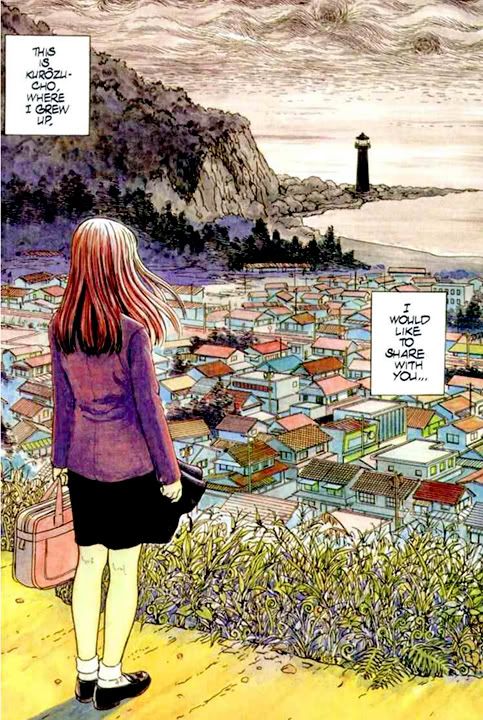
It begins with those simple words. They might lead you to expect some sort of nostalgia trip, a charmingly funny autobiographical tale of young love in a small, seaside town. But look closer. Now you begin to sense something ominous in the moody sky, a black lighthouse on a stark, rocky jetty. The girl's hair and skirt stir in a wind that must be unpleasantly cold, rather than refreshing, and we see only her back, alienating us rather than drawing us in the way an image of her face might. And the grass.
Look closely at the grass.
As I've written before, Uzumaki is the only comic I've read in years that actually scared me. And more than that, it left me feeling... well, disturbed is too strong a term... uneasy. It presents such a progression of horrors, each building on the last, I actually felt a growing dread with each story. Have you ever truly been frightened by something you've read? Horror comics-- even DC's relatively tame offerings in the 1970s-- used to keep me awake nights but years of hard living have put callouses on my imagination. I can read EC's best without flinching. Twisted Tales? Not a problem now. 30 Days of Night did nothing but disappoint me on almost every level, and while I enjoy The Walking Dead, it's more for the intense action and characterizations rather than its fright value.
But Uzumaki? Uzumaki brings back that easily creeped-out child I used to be.
I really wanted to do a Spookey Month entry on Uzumaki, but I haven't read it in several years and don't have it with me here in Japan. If I'd been smarter, I could've bought it back in September. But nope.
Saturday, October 31, 2009
Spookey Month: "Night of the Reaper" from Batman #237
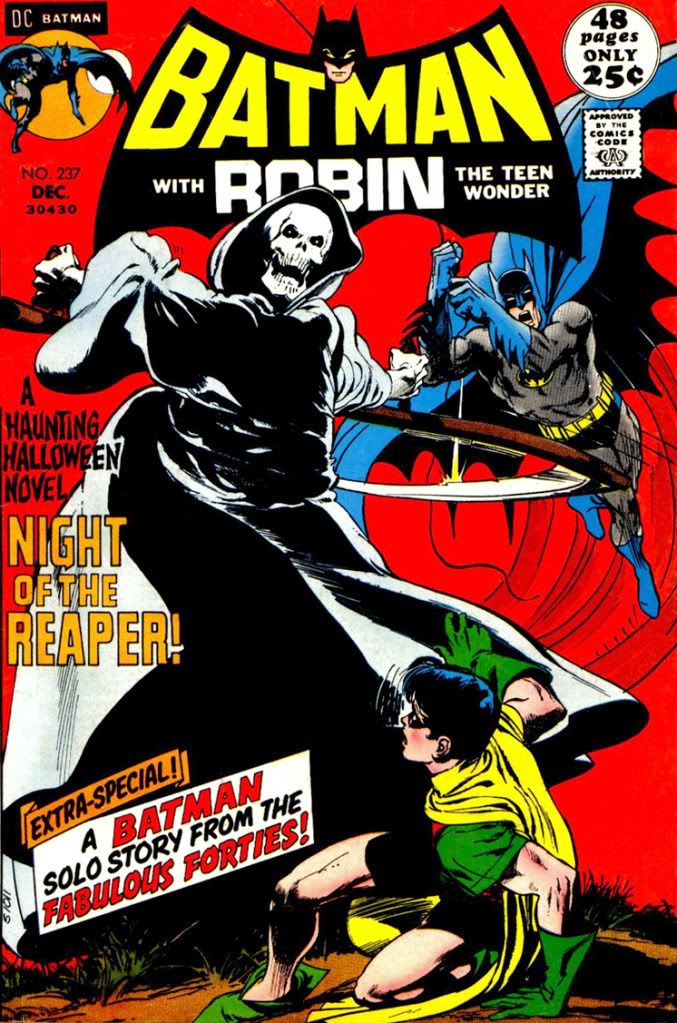 Here's a Halloween treat-- "Night of the Reaper," with Batman and Robin in Rutland, Vermont, for the annual Rutland Halloween Parade plus a swingin' shindig for all the groovy cats and chicks at superfan Tom Fagan's house. And more Nazis than you can shake a roll of Smarties at. Kids of all ages (and Nazi war criminals) love this classic candy treat.
Here's a Halloween treat-- "Night of the Reaper," with Batman and Robin in Rutland, Vermont, for the annual Rutland Halloween Parade plus a swingin' shindig for all the groovy cats and chicks at superfan Tom Fagan's house. And more Nazis than you can shake a roll of Smarties at. Kids of all ages (and Nazi war criminals) love this classic candy treat.Ah, what a pedigree this story has. The script is by Denny O'Neil "from an idea by Berni Wrightson with an assist from Harlan Ellison" and the art is by Neal Adams and Dick Giordano.
It opens with an eerily atmospheric splash page, a dark image of the lonely body of a dead Batman bathed in the light of a Halloween full moon. The narrative captions tell us a light is blinking on and off on top of the house in the background, but it's not visible.
What is visible, however, is Dick Grayson and his college pals on their road trip to Rutland. Since it's 1971, guys unashamedly stroll around in public wearing purple vests or full-on safari outfits and tall leather boots. Of course, it is Halloween. Dick's vest is only slightly more flamboyant than what the other revelers have on. Another clue that it's the 70s is Dick's nonchalant attitude towards one of his friend's possible drug use when someone mentions the guy's weird behavior:
"Right!... and gulping coffee and who-knows-what-else to keep his eyes open."
Dick, possession of schedule 1 narcotics is a crime. You're a crime-fighter. Why are you making with the quips when you should be punching this guy straight? I mean as Batman's partner should Robin be so casual about this one-man Fear and Loathing at the Rutland Halloween Parade?
I knew a guy in junior college who sold LSD to truck drivers who needed a little pick-me-up on cross-country hauls, so maybe this guy is tripping to stay awake. He seems intent on the parade floats in a manner consistent with hallucinogen use. But perhaps he's on methylamphetamines or PCP. Whatever's got him so twisted, Batman is going to be really disappointed his ward puts being a "big man on campus" ahead of doing his sworn duty as a superhero sidekick.
No matter. There's a party at Tom Fagan's! And as the bespectacled fellow in menacing black jackboots says, "Where a party is, girls is." Unless that party involves sausage, my friend. Ever been to one of those? Nothing but lighting farts and watching Rambo movies, not a girl in sight.
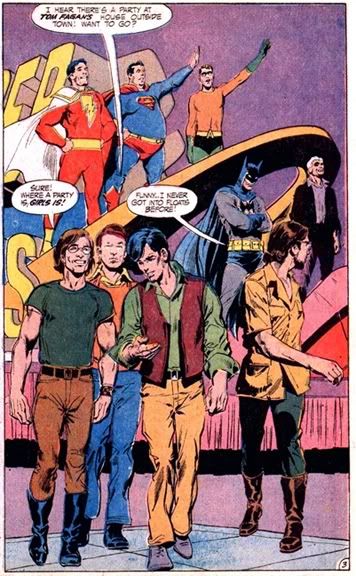 Who is Tom Fagan? Tom Fagan was a real person, who lived in Rutland. He was a newspaper reporter and comic book fan who served as the Halloween parade's chairman. Fagan built the parade into a major event featuring floats from both Marvel and DC, and according to an October 2008 story in the Rutland Herald, 181 different comic characters at one point. A caption in the lower left corner of page two of this story promises "any similarity to actual persons or places depicted in this tale is probably a stranger tale than you'd ever really believe!"
Who is Tom Fagan? Tom Fagan was a real person, who lived in Rutland. He was a newspaper reporter and comic book fan who served as the Halloween parade's chairman. Fagan built the parade into a major event featuring floats from both Marvel and DC, and according to an October 2008 story in the Rutland Herald, 181 different comic characters at one point. A caption in the lower left corner of page two of this story promises "any similarity to actual persons or places depicted in this tale is probably a stranger tale than you'd ever really believe!"
Not really. Comic book companies send costumed representatives to a Halloween parade. Some of their employees and artists go there to enjoy the festivities. Wrightson and Ellison pitch a story about it, O'Neil writes it, Adams puts a lot of his young comic book proteges in the story, along with Tom Fagan himself. Cool, but far from strange.
But it sure makes it seem these comic book guys were living out wacky adventures beyond the ken of us fans, huh? I remember thinking so when I read this story in some reprint book years ago. Batman From the 30s to the 70s? The Greatest Batman Stories Ever Told? Oh, how I wanted to draw them funny books and go to Rutland in them thar days. But mah gold claim came a-cropper an' I had to change professions to muleskinnin' and then thar was mah stint dealin' faro in Tombstone. I remember when them Clantons threw down with the Earp brothers and Doc Holliday outside of Fly's Photography Studio...
 Where was I? Oh yeah, Rutland not the Old West. How often I get the two confused; they're quite similar. Since this is a Batman and Robin action joint and not a college romance or some kind of Cheech and Chong story, O'Neil quickly sends Dick Grayson into a fight. He spots a guy in a Robin outfit getting the snot beat out of him and-- imagining it's himself-- goes to help. The drugged-out safari guy blunders around, oblivious to the violence around him and causes Dick to take a blackjack to the skull. Recovering, Dick slips away from the DC arti-- er-- his college pals, switches to Robin and chases the thugs. But look!
Where was I? Oh yeah, Rutland not the Old West. How often I get the two confused; they're quite similar. Since this is a Batman and Robin action joint and not a college romance or some kind of Cheech and Chong story, O'Neil quickly sends Dick Grayson into a fight. He spots a guy in a Robin outfit getting the snot beat out of him and-- imagining it's himself-- goes to help. The drugged-out safari guy blunders around, oblivious to the violence around him and causes Dick to take a blackjack to the skull. Recovering, Dick slips away from the DC arti-- er-- his college pals, switches to Robin and chases the thugs. But look!
It's the dead Batman from the splash page! Robin mistakes the corpse for the real Batman:
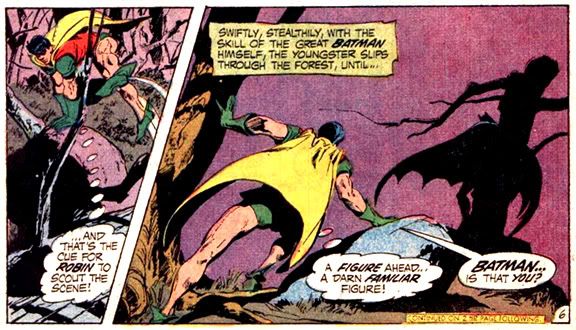 Then Robin gets his ass handed to him for the second time that night and falls into some kind of drainage ditch or broken sewer line:
Then Robin gets his ass handed to him for the second time that night and falls into some kind of drainage ditch or broken sewer line: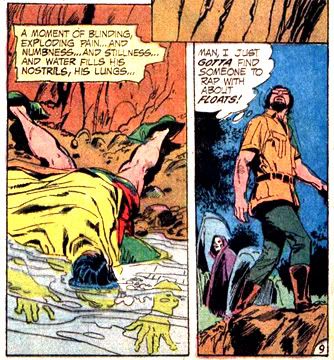 Yes, for any purpose Robin is useless. Well, that's not true. He's good as a sparring partner because he's easy to beat. Managers of third rate boxers often hire him to build their fighters' confidence. I've never been a proponent of the sidekick, and this story illustrates why.
Yes, for any purpose Robin is useless. Well, that's not true. He's good as a sparring partner because he's easy to beat. Managers of third rate boxers often hire him to build their fighters' confidence. I've never been a proponent of the sidekick, and this story illustrates why.
And just as Robin drowns, our story's comedic relief passes by, hoping to discuss floats with someone, or in the parlance of the time, rap. He wants "to lay it on" someone, "to groove" and perhaps even "to grok." He would like "to talk turkey," without any "jive hassles" or "the Man coming down" on him. He wants to do these things with anyone but furtive little guys in purple robes. Those he ostracizes as unworthy of float-rapping. He's starting to remind me of that "Eat at Joe's" bear from the classic Tex Avery cartoon "Jerky Turkey."
Robin awakens upstairs at Tom Fagan's house and there's his old pal Batman and... GAAAAHHHH!
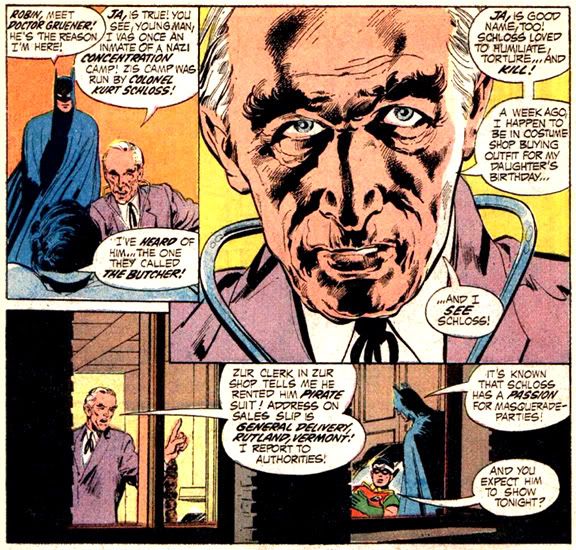 Oh, sorry. It's just kindly Dr. Gruener. For a second there I thought Robin had died and that dessicated visage was the Grim Reaper. And here's where the plot kicks in. Gruener, a concentration camp survivor, recently spotted Nazi fugitive Colonel Kurt Schloss in Rutland. He reported the war criminal to the authorities and they sent Batman for some reason, instead of the FBI.
Oh, sorry. It's just kindly Dr. Gruener. For a second there I thought Robin had died and that dessicated visage was the Grim Reaper. And here's where the plot kicks in. Gruener, a concentration camp survivor, recently spotted Nazi fugitive Colonel Kurt Schloss in Rutland. He reported the war criminal to the authorities and they sent Batman for some reason, instead of the FBI.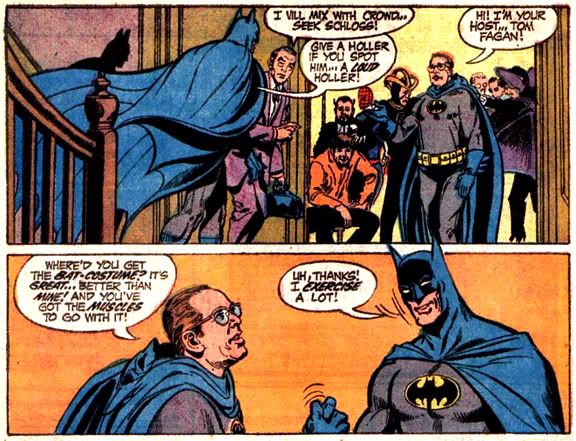 Now that Batman has shown up, O'Neil and Adams pay tribute to Tom Fagan buy having him meet the dread Batman himself. And Adams takes the opportunity to draw more friends and poke fun at the Distinguished Competition... wait. That's Marvel's name for DC, not the other way around. Anyway, here's a muscular oaf dressed like Thor with a colander on his head:
Now that Batman has shown up, O'Neil and Adams pay tribute to Tom Fagan buy having him meet the dread Batman himself. And Adams takes the opportunity to draw more friends and poke fun at the Distinguished Competition... wait. That's Marvel's name for DC, not the other way around. Anyway, here's a muscular oaf dressed like Thor with a colander on his head: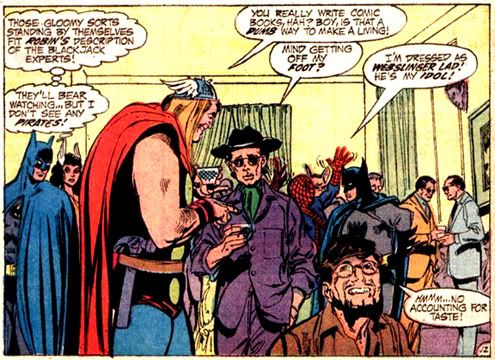 When he gets off that guy's foot, he's going into the kitchen to strain spaghetti for the "dead witch" routine.
When he gets off that guy's foot, he's going into the kitchen to strain spaghetti for the "dead witch" routine.
The plot has to do with Nazi gold and an assassination attempt on Schloss by his former friends. Batman starts kicking ass and taking names, as Batman is wont to do. We even get an early iteration of the now-cliched "Batman threatens to kill a guy in a high place" scene, despite there being no record of Batman ever having actually killed anyone:
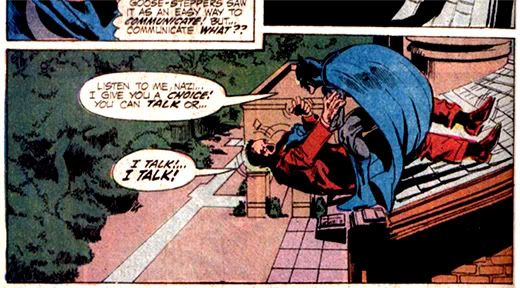 There's a twist in that Dr. Gruener isn't exactly on the up-and-up and things get a bit dodgy plotwise. It starts off well: Robin's motivation for being in Rutland is natural; he's trying to have fun and meet some cute chicks. That Nazis are also in Rutland the very same night trying to kill one of their own (who conveniently loves costume parties) and this somehow means also murdering Batman and Robin or people dressed like them is overly coincidental.
There's a twist in that Dr. Gruener isn't exactly on the up-and-up and things get a bit dodgy plotwise. It starts off well: Robin's motivation for being in Rutland is natural; he's trying to have fun and meet some cute chicks. That Nazis are also in Rutland the very same night trying to kill one of their own (who conveniently loves costume parties) and this somehow means also murdering Batman and Robin or people dressed like them is overly coincidental.
I find that's frequently a problem with the Caped Crusader-- actually having a logical reason for him to investigate or otherwise involve himself in whatever crime is going on. You can't just have him overhear the criminals and jump off a rooftop onto them every time. Here, Batman has been sent on official business but the story turns on a surprisingly slapdash decision by one of the supporting characters that spoils its twist. At least we get one of those patented Denny O'Neil "Batman succeeds but he fails" downer endings. Batman in the 1970s was fallible and self-questioning and a whole hell of a lot more likable than the more recent version, who I find reprehensible and random.
But despite some awkward turns this story is a lot of fun, especially around Halloween time. You can find it reprinted in Batman Illustrated by Neal Adams volume three.
Monday, October 26, 2009
Spookey Month: I Love Marvel's Tomb of Dracula Series Even When It's Silly!
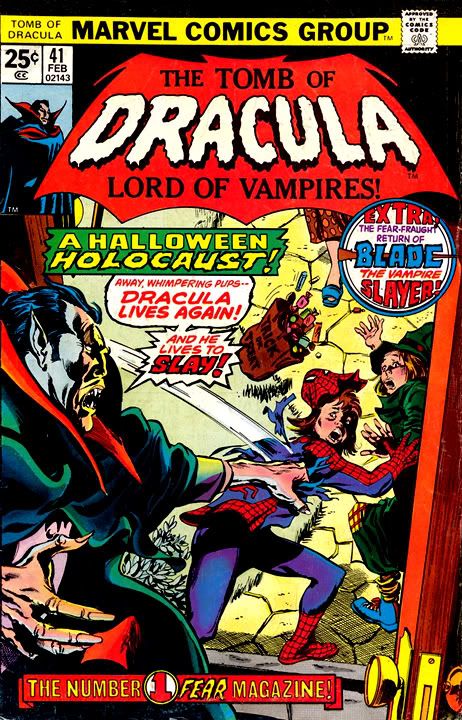 I’m a horror traditionalist. I don’t enjoy “torture porn” like the Saw series or the movie Hostel. Those kinds of horrors you can find in real life if you look hard enough. I’m more into the classics—ghosts, Frankenstein’s monster, werewolves and vampires. I do have a weakness for Japanese horror, mostly for its dream-logic and different feel from our Eurocentric horror tradition; but many of these stories also involve ghosts.
I’m a horror traditionalist. I don’t enjoy “torture porn” like the Saw series or the movie Hostel. Those kinds of horrors you can find in real life if you look hard enough. I’m more into the classics—ghosts, Frankenstein’s monster, werewolves and vampires. I do have a weakness for Japanese horror, mostly for its dream-logic and different feel from our Eurocentric horror tradition; but many of these stories also involve ghosts.The king of Halloween for me is Count Dracula. And Marvel’s Tomb of Dracula is one of my favorite series. I’ve always admired Marv Wolfman’s slightly hysterical prose. That mid-70s heavyhanded narrative stuff suits Tomb’s dark, atmospheric storylines. And of course Gene Colan and Tom Palmer as an art team are second to none. Palmer ably translated Colan’s chiarascuro-laden artwork into printable form, and Colan’s page layouts and oddly-angled panels are just thick with mood and menace.
And our star! Wow! Marvel’s Dracula was an anti-hero masquerading as a villain. A pontificating killer with an out-of-control ego and equal parts misogyny and misanthropy, but Wolfman imbued him with charisma. It’s hard not to admire this hateful bastard as he escapes time and again, turning into mist or a bat to elude his clumsy enemies. Every so often the creative team would have to introduce someone even nastier than Dracula to liven things up. One of these antagonists was Dr. Sun, a disembodied brain obsessed with usurping Dracula’s powers and killing the Count.
What is it with comic books and Red Chinese plots to remove people’s brains? DC’s Weird War Tales had a story in which an American officer gets his brain cut by the Chinese Communists out to power a supercomputer. Batman’s vaguely Arabic enemy R’as al Ghul once took out a scientist’s brain for some nefarious purpose; R’as is neither a commie nor Chinese so maybe this trope is just evidence of a generalized western paranoia against the East. Then again, Nazis tend to do this as well so maybe I'm completely off base.
Anyway, Dr. Sun is another of these floating brains from Asia and he and his organization of sycophants and henchpeople have infiltrated America. Dracula crosses the Atlantic by stowing away in a Royal Air Force fighter only to get himself killed by Dr. Sun.
Which sets up the strange turn of events in Tomb of Dracula #41. It would be ironic if it wasn't actively stupid. Drac’s long-time enemies, led by Quincy Harker, enlist the US Army to fight Dr. Sun but Sun hypnotizes the soldiers and makes them his slaves. So Harker and company turn to the one person—in all the Marvel Universe, populated by fantastic quartets and avenging and defending superteams—who can help them. That's right.
Dracula.
 Well, one member of the group has a very personal reason-- Aurora Rabinowitz has a crush on Dracula, so much so she thinks "even his ashes are cute." Love-- even the arbitary love enforced on an annoyingly dense comic book character by her creator-- makes people think and do ridiculous things. But vampire hunters? It's really difficult to understand vampire hunter logic: "We were fighting Dracula and a brain. Then the brain killed Dracula and we only have to fight the brain now. So let's bring back Dracula so we can fight the brain and Dracula again, only Dracula will probably kill the brain for us so after that we can..."
Well, one member of the group has a very personal reason-- Aurora Rabinowitz has a crush on Dracula, so much so she thinks "even his ashes are cute." Love-- even the arbitary love enforced on an annoyingly dense comic book character by her creator-- makes people think and do ridiculous things. But vampire hunters? It's really difficult to understand vampire hunter logic: "We were fighting Dracula and a brain. Then the brain killed Dracula and we only have to fight the brain now. So let's bring back Dracula so we can fight the brain and Dracula again, only Dracula will probably kill the brain for us so after that we can..."
Maybe this kind of plan makes sense if you've been fighting the undead for years and you're really low on sleep and sanity. Only Rachel van Helsing-- possibly because Dracula's bats scarred her pretty face a few issues back-- attempts to convince them not to do this stupid, stupid thing and they vote her down. But even she fails to make the ultimate argument against this counter-intuitive plan to bring back their arch-nemesis.
Superheroes.
What about Iron Man? He was always fighting the Reds. Even a psychic Red in a big pickle jar wouldn’t stand a chance, right? And Thor. Being a Norse god, Thor could… No, the choice is Dracula, dammit. We tried the army and they failed, so why bother the superheroes who regularly defeat nigh-omnipotent earth-eating entities with casual ease? We need our filthy vampire back.
Well, we know the real reason they have to revive Dracula. It's because his name is in the book's title. If the book had been called Rachel van Helsing's Common Sense Brigade, Dracula would have stayed dead until some editor-writer team needed him for another book. And despite Dr. Sun's having taken several issues to weaken and then kill the Count, Wolfman brings him back in within a few panels (beautifully drawn, by the way) in such a ridiculous, perfunctory way good taste and respect for Marv Wolfman prevent me from telling you how it happens. It involves the insipid Aurora, though.
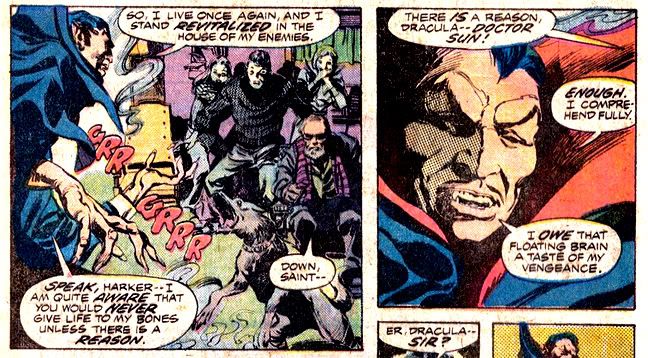 Blade shows up, too. He really razzes the gang and gives them the business for bringing back Dracula. Such cads and bounders are they, in league with a scoundrel; they're in dire need of a good ostracizing and Blade is just the toff to do it, indeed. Blade company argue for two whole pages in circular fashion before Rachel kicks Blade out. And then Wolfman gives us a casual reminder that Marvel's universe is full of fabulous super-people who are much better choices for aid than an evil vampire; two kids go out trick-or-treating, one dressed as the amazing Spider-Man.
Blade shows up, too. He really razzes the gang and gives them the business for bringing back Dracula. Such cads and bounders are they, in league with a scoundrel; they're in dire need of a good ostracizing and Blade is just the toff to do it, indeed. Blade company argue for two whole pages in circular fashion before Rachel kicks Blade out. And then Wolfman gives us a casual reminder that Marvel's universe is full of fabulous super-people who are much better choices for aid than an evil vampire; two kids go out trick-or-treating, one dressed as the amazing Spider-Man.
Oh yeah, forgot to tell you-- this story takes place on Halloween! The kids get only an hour to rack up the candy, though. What a strict mother they must have! But she hasn't given her kids any more smarts than this story's main characters, because the little dumbasses promptly make their way to Dr. Sun's house. Yes, house. He's a brain in a jar trying to conquer the world and his secret base is in a house in an ordinary residential area.
The kids get only an hour to rack up the candy, though. What a strict mother they must have! But she hasn't given her kids any more smarts than this story's main characters, because the little dumbasses promptly make their way to Dr. Sun's house. Yes, house. He's a brain in a jar trying to conquer the world and his secret base is in a house in an ordinary residential area.
The kids notice something is... well... a little strange about this place. After all, you don't often see hundreds of heavily-armed soldiers lounging around in suburbia. There must be some tanks and jeeps around, too because just three issues before they'd all gone off to battle Dr. Sun with a full combat brigade, right though the heart of the city.
National emergencies involving the mobilization of US Army troops on American soil are no reason to cancel the fun of Halloween, though. And I'm not sure what Dr. Sun really wants with these soldiers because they're not very competent at guarding his house:
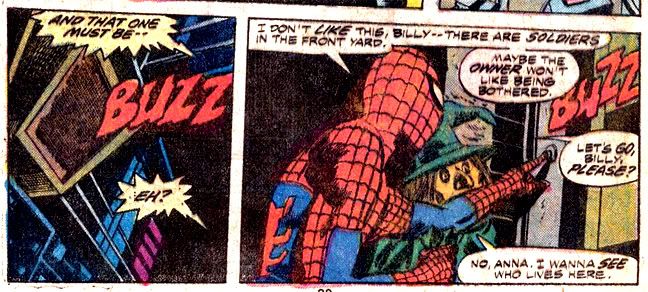 Two kids in costumes infiltrate right up to the front door and ring the buzzer. Let's see what's happening inside:
Two kids in costumes infiltrate right up to the front door and ring the buzzer. Let's see what's happening inside: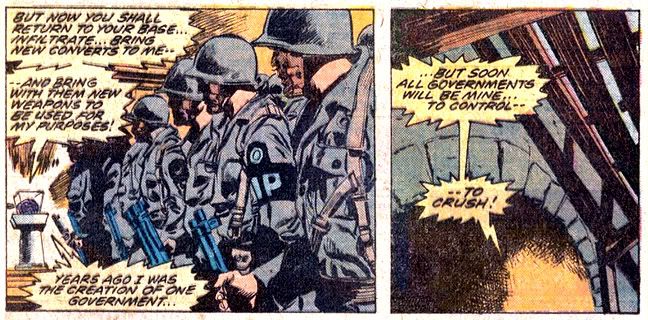 Oh, they're not guarding him. They're just standing around letting him scream at them via mental waves or some kind of electronic voice device. They're supposed to go round up all their friends and bring them back to Sun's place for a big Halloween shindig/mind control party. It's kind of like an Amway recruitment drive.
Oh, they're not guarding him. They're just standing around letting him scream at them via mental waves or some kind of electronic voice device. They're supposed to go round up all their friends and bring them back to Sun's place for a big Halloween shindig/mind control party. It's kind of like an Amway recruitment drive.
As for the kids, they never get their candy. Blade and Dracula crash the house and start tearing the place apart, dancing to the latest tunes and putting the Misfits' version of Bobby "Boris" Pickett and the Crypt-kickers' "Monster Mash" on repeat play until Dr. Sun makes them stop and they all settle in to eat candy corn and watch the Halloween movie series on DVD, then tell ghost stories while passing around a flashlight to hold under their chins. Scary stuff!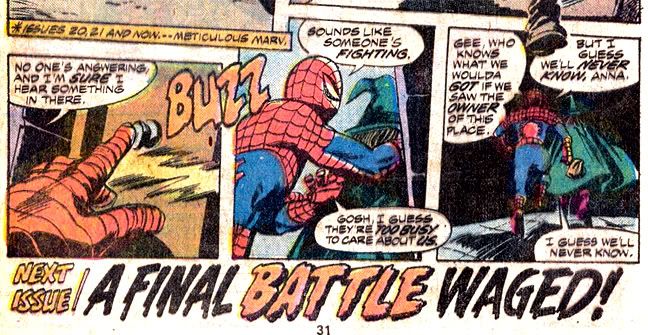 It's too bad our impatient trick-or-treaters didn't ring the doorbell one more time instead of running off, because Dr. Sun gives out those fun-sized chocolate bars. Milky Way, Snickers and more!
It's too bad our impatient trick-or-treaters didn't ring the doorbell one more time instead of running off, because Dr. Sun gives out those fun-sized chocolate bars. Milky Way, Snickers and more!
Tuesday, October 20, 2009
Spookey Month: Museum of Terror 3: Long Hair in the Attic: A Comic Review
 Museum of Terror 3: Long Hair in the Attic
Museum of Terror 3: Long Hair in the AtticPublisher: Dark Horse Comics
Stories and Art by Ito Junji
Now that my favorite anti-hero Tomie has met her fate-- or has she? Cue ominous music-- Ito Junji tells a series of one-off horror stories in volume 3 of Dark Horse’s wonderfully disgusting Museum of Terror series. Actually, the stories in Long Hair in the Attic pre-date the Tomie Saga (as I like to call it). These are from early in Ito’s career, when he was still working as a dental technician.
I don’t know how much influence working in an industry so devoted to pain and torture had on Ito’s oeuvre, but I’m guessing there’s at least a teeny bit of orthodontic cruelty hidden in each and every story.
Long Hair opens with “Bio-House,” a distaff vampire tale that seems equally influenced by Bram Stoker and David Cronenberg, or perhaps even Stanley Kubrick with its opening aerial shots of a traveling car. Kubota, a young biotechnology company employee, is invited by her boss for dinner at his country house. It seems they share a “yen for unusual cuisine,” which is the hook Ito uses to explore various aspects of zoophagy and haemophagia.
He's obviously partially inspired by Stanley Kubrick's The Shining:
 In this offering, Ito’s linework betrays a certain lack of confidence. But as the stories progress, Ito quickly gains in skill and self-assurance. That’s one of the charms of volume 3- watching Ito’s growth as an artist and writer, and his introduction of his various ongoing concerns and themes.
In this offering, Ito’s linework betrays a certain lack of confidence. But as the stories progress, Ito quickly gains in skill and self-assurance. That’s one of the charms of volume 3- watching Ito’s growth as an artist and writer, and his introduction of his various ongoing concerns and themes.
Like many modern horror auteurs in various media, Ito relies grotesque imagery relating to various violations of the human body. This may be relatively restrained, as in “The Face Burglar,” where a vicious gang girl gives a mutant her comeuppance, or almost rococo in its ornately gory detail; for example, when Ito depicts the fate of both protagonists of “Den of the Sleep Demon,” literally turning them inside-out as they merge, “on-camera.”
While chock full of this sort of delightful nastiness, Terror 3’s main attraction is in charting the growth of Ito's distinctive voice. Even in the crude early tales, his nightmarish story-logic and recurring motifs and concerns are already evident, developing rapidly over the three year period covered by these works. Along with the first two volumes, this collection also adds to an already strong case for Ito as one of horror’s finest practitioners. He's definitely pre-eminent in the graphics form.
Because he’s not content with merely pushing the boundaries of physical transformation, Ito’s horror stories at their best are crafty dissections of cherished institutions. He delights in revealing all their nasty little secrets as he both subverts and perverts government, religion, friendship, romantic relationships even that most ostensibly secure of social units, the nuclear family.
In “Village,” two young adults return to the rural village they abandoned years before to visit their parents. They find the place in thrall to a massive siren that sounds all night, every night.
As Japan’s population ages and economic necessities force the abandonment of the traditional family structure (younger generations living with and caring for the older), it’s becoming increasingly common for young people to leave smaller towns for places like Osaka and Tokyo.
But what happens to their cast-off parents? In Ito’s imagination, they fall prey to reincarnated sorcerers and transformation into demonic, bat-winged creatures, a scenario with apocalyptic implications. Still, true to form, Ito's vision doesn’t lend itself to a simple conservative reading; the young people who stay behind to do their duty suffer madness and death. As horror is by its nature a nihilistic genre, even adhering to societal values offers no escape.
The title story combines many elements of Ito's subtextual favorites. In “Long Hair in the Attic,” a young woman suffers through a painful breakup with her shallow lover, despite her having grown out her luxurious black hair. Desiring change, she asks her sister to help her chop off it all off. So far, pretty prosaic stuff, almost slipping into romance comic-land… but the hair has ideas of its own, including designs on the old boyfriend.
Malevolent, sentient hair? This is one of the earliest indications that Ito is a true original, and the story’s key visual, that of the lovelorn woman’s head being borne up the steps into the attic on a spidery wave of hair is fairly unprecedented. Unless you count some of the grisly images from John Carpenter’s The Thing.
But if you want something really dark and worrisome, let me direct your attention towards “The Bully.” This queasy short begins with Kuriko breaking up with her current boyfriend to enter a relationship with a man she tortured as a child. After their wedding, Kuriko's former victim fathers a child with her, then abandons them both as his revenge. Driven to madness by parental responsibilities and increasingly obsessed with her child’s resemblance to the boy she once knew, Kuriko reverts to type in a sequence that is absolutely pitiless. With the mother-child bond being one of society’s most sacred, “The Bully” is a profoundly disturbing tale.
While its final page and a half doesn’t match Ito’s other climaxes for overt violence, this perversion of motherhood and its promise of further physical and emotional violence is easily Ito’s nastiest achievement in this volume. Its counterpart can be found in “Heart of a Father,” another dark exploration of family ties, this time with a malevolent father causing all the trouble. It’s creepy, but since it involves a group of siblings it can’t equal “The Bully” and the lonely fate of Kuriko's innocent child.
The book concludes with “A Deserter in the House,” where a rural family has been hiding a friend who went AWOL from the Japanese army during WWII… although it's now eight years after the atomic bombs ended the war. They even stage visits from a phony army inspector hot on the man's trail as part of the family's elaborate revenge over the death of a sister in an American air raid. The shock ending is effective, but surprisingly conventional for Ito.
Once again, Dark Horse has put together an excellent package, containing all the strengths of the first two volumes. And yes, again, one positive adding a great deal to the book's enjoyment is the fine translation work by Naomi Kokubo and Eric-Jon Rossel Waugh. I especially like the line, "It blows my mind that such a pretty thing like you would be into gross food."
Under the loving caress of Ito Junji's relentlessly dark imagination, gross is a well-chosen understatement! And really, all of Volume 3 is food that's at once gross and delicious... even if it's a apt to lead to indigestion and sleeplessness. Just toss some of those miniature chocolate bars on top for the perfect Halloween.

